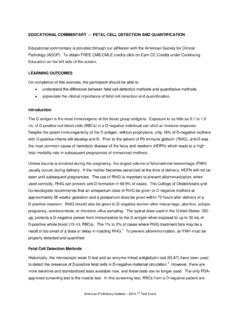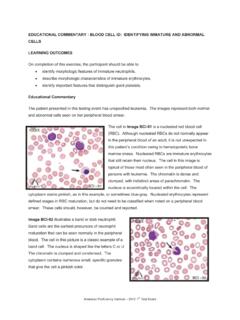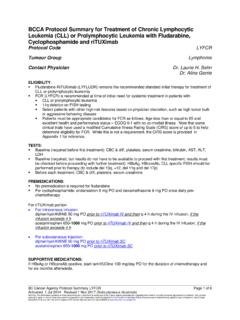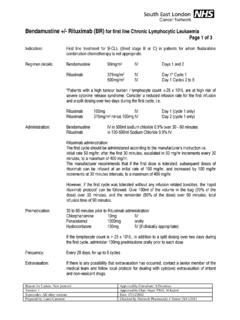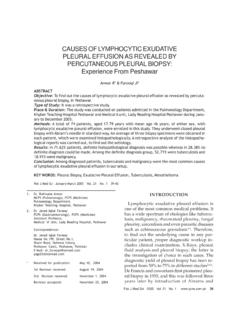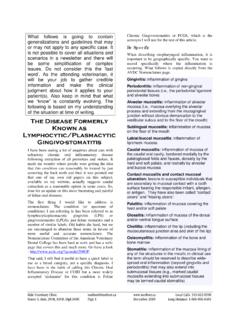Transcription of EDUCATIONAL COMMENTARY – SMUDGE CELLS: USELESS …
1 EDUCATIONAL COMMENTARY SMUDGE cells : USELESS ARTIFACT OR PROGNOSTIC INDICATOR? EDUCATIONAL COMMENTARY is provided through our affiliation with the American Society for Clinical Pathology (ASCP). To obtain FREE CME/CMLE credits, click on Earn CE Credits under Continuing Education on the left side of the screen. **Florida licensees, please note: This exercise will appear in CE Broker under the specialty of Hematology. Learning Objectives On completion of this exercise, the participant should be able to identify SMUDGE cells on a peripheral blood smear; explain the potential significance of reporting SMUDGE cells ; discuss reasons for not reporting SMUDGE cells ; and describe when and how to count SMUDGE cells . Introduction SMUDGE cells are traditionally associated with chronic lymphocytic leukemia (CLL), but can occur in many other situations. For more than a hundred years they were thought to be a simple artifact from the slide-making process1, but in the past ten years, a growing number of research studies have linked increased SMUDGE cells in patients who have already been diagnosed with CLL to a longer overall survival This approach is not yet widely embraced in the medical laboratory community.
2 Many pathologists consider the presence of SMUDGE cells to be a nonspecific finding and that it is not necessary to include them on the patient ,4,5 What Is a SMUDGE Cell? SMUDGE cells , sometimes referred to as basket cells , are remnants of leukocytes without cytoplasmic structure; sometimes only bare nuclei are They are literally smashed, or smudged, by the physical glass-on-glass action of making a routine differential slide in the laboratory, either with an automated slide maker or a manual push smear. The degree of smudging can be reduced by preparing a 1:5 or 1:10 mixture of blood with bovine albumin before making the smear. The albumin acts as a cellular cushion for fragile leukocytes and improves accuracy in counting a white blood cell differential. Increased numbers of SMUDGE cells are most often associated with lymphoproliferative disorders, especially chronic lymphocytic leukemia (CLL),6 because the lymphocytes are more fragile in these SMUDGE cells in patients with CLL are ruptured B-cell lymphocytes, but are indistinguishable morphologically from other disintegrated lymphocytes.
3 American Proficiency Institute 2017 1st Test Event EDUCATIONAL COMMENTARY SMUDGE cells : USELESS ARTIFACT OR PROGNOSTIC INDICATOR? (cont.) SMUDGE cells . A variety of diseases and other factors such as infectious mononucleosis, T-cell leukemias and other small-cell lymphoproliferative disorders, or even old blood and improper handling can produce SMUDGE cells on a complete blood cell count (CBC) smear. Leukocytes begin to disintegrate after 4 hours at ambient temperature, or 24 hours in EDTA at 4 - 8 Stability is affected by storage at temperatures that are too warm or too cold, or by overly vigorous mixing. Even routine smears on hospital patients can have SMUDGE cells due to rapid cellular turnover. Some smudged cells can still be recognized as neutrophils, monocytes, eosinophils, and if positive identification can be made, they can be included in a differential, according to individual laboratory policy. However, they are not reported as SMUDGE cells if they are counted as their individual cell type, such as eosinophil.
4 Bare nuclei cannot be identified as anything other than a SMUDGE cell. Disintegrated eosinophil. Disintegrated neutrophil. American Proficiency Institute 2017 1st Test Event EDUCATIONAL COMMENTARY SMUDGE cells : USELESS ARTIFACT OR PROGNOSTIC INDICATOR? (cont.) Infectious mononucleosis. Clockwise from top: SMUDGE cells (2), reactive lymphocyte, neutrophil. Rare lymphoproliferative disorder of natural killer (NK) cells and T cells (by flow cytometry). Two SMUDGE cells and 1 small lymphocyte. In the context of old blood, reporting the presence of SMUDGE cells will have no clinical significance to the physician. It could even lead to an erroneous supposition of CLL, in particular if the neutrophils have markedly disintegrated because of specimen age, leading to a relative, false lymphocytosis. In such instances, the overall white blood cell count is usually normal. Chronic lymphocytic leukemia typically presents with an increased number of small mature lymphocytes, along with the presence of SMUDGE cells .
5 Some refer to these CLL lymphocytes as soccer-ball lymphocytes because the nucleus is very mature, dark, and can have a cracked Chronic lymphocytic leukemia (CLL). Five small, mature lymphocytes. Slide prepared with albumin to minimize smudging. American Proficiency Institute 2017 1st Test Event EDUCATIONAL COMMENTARY SMUDGE cells : USELESS ARTIFACT OR PROGNOSTIC INDICATOR? (cont.) Many different scenarios can lead to SMUDGE cells on a slide, but because the presence of SMUDGE cells traditionally implies CLL, it is not currently standard practice in the United States to report SMUDGE cells in any context other than CLL, and then usually only as present, without quantitation or grading. SMUDGE cell reporting requires the agreement and understanding of the community s hematology oncologists. Staging and Treatment of Chronic Lymphocytic Leukemia (CLL) Chronic lymphocytic leukemia is the most common type of adult leukemia in the US and the UK, and rare in Asian countries.
6 Most people are diagnosed during routine CBC testing before developing any CLL is diagnosed by demonstrated lymphocytosis (>5000 lymphocytes per microliter of blood) and confirmed by flow cytometry or genetic testing of the blood or bone marrow, where available. As the disease progresses, the B-cell lymphocytes grow uncontrolled in the bone marrow where they crowd out normal cells , leading to anemia and infections. Staging by the Rai or Binet classification systems to determine the extent of the disease is based on blood counts and physical manifestation of lymphocyte involvement, such as enlarged spleen, liver, or lymph The higher the staging classification, the poorer the prognosis, and the sooner treatment is required to manage symptoms. CLL is generally considered an incurable CLL is often so slow to progress that treatment is not initiated until the disease stage indicates the patient s quality of life is being Some patients can live normal lives for decades before treatment is required, but approximately 30-40% have a rapidly progressing form,1 requiring aggressive treatment to control it.
7 Individual Studies on Significance of Reporting SMUDGE cells in CLL United States, 2007 and 2009. The Mayo Clinic conducted two similar studies that suggested that the number of SMUDGE cells on smears for patients with CLL may be more significant than the customary assumption of smear artifact. Their studies focused on vimentin, a cytoskeletal protein that is integral in lymphocyte cellular rigidity. Vimentin has separately been associated with poor prognosis in breast and colon cancer, as well as in leukemia. Patients with CLL with low vimentin expression have a high percentage of SMUDGE cells ( , increased cell fragility). The percentage of SMUDGE cells out of the overall lymphocyte total was determined, and a threshold of 30% SMUDGE cells confirmed the risk for aggressive disease. Patients with less than 30% SMUDGE cells showed shorter time to requiring treatment for symptom management and shorter overall survival. Patients with more than 30% SMUDGE cells demonstrated much longer overall survival.
8 The percentage of SMUDGE cells is directly proportional to survival time and timetable for American Proficiency Institute 2017 1st Test Event EDUCATIONAL COMMENTARY SMUDGE cells : USELESS ARTIFACT OR PROGNOSTIC INDICATOR? (cont.) needing to begin treatment. SMUDGE cell percentage is almost universally available, even in basic laboratories, and does not require expensive, high-tech equipment or specialized ,7 Brazil, 2009. This study considered whether the presence of SMUDGE cells was diagnostic for CLL. Analysis of 125 patients with chronic B-cell lymphoproliferative diseases found that there were definitively more SMUDGE cells in CLL than in the other diseases, but specificity was not high enough to make the diagnosis of CLL from the presence of SMUDGE France, 2013. This flow cytometry study showed that low CD45 expression was an indicator of increased cell fragility in CLL. Because increased cell fragility also correlates with increased SMUDGE cells on the smear, the researchers were making a parallel point about monitoring cell fragility as a prognostic indicator.
9 The study found that CLL cells from patients with more than 36% SMUDGE cells had very low levels of CD45, correlating with the cutoff of 30% used in the studies from the United States, India, and Senegal. Low levels of CD45 and increased CLL cell fragility are associated with longer time until treatment is India, 2014. This study states CLL is a common disease in the West, but relatively rare in India. The authors reviewed records covering 12 years, from 2000 to 2011, and analyzed the percentage of SMUDGE cells in 222 patients previously diagnosed as having CLL by flow cytometry. This study came to a similar conclusion as the American studies; patients with 30% or fewer SMUDGE cells had much more advanced disease and lower overall survival. The authors also concluded that SMUDGE cell percentage could be useful in following CLL patients in situations with limited Senegal, 2015. Chronic lymphocytic leukemia can present either as an aggressive leukemia or as an indolent form that will not require treatment for many years.
10 Flow cytometry and cytogenetic analysis can provide very specific markers for staging and treatment of disease, but many laboratories in developing countries do not have the equipment available for such tests. This study of 42 patients diagnosed as having CLL found a strong correlation between low numbers of SMUDGE cells (< 30%) and advanced-stage disease. The authors propose using SMUDGE cell percentage as a less expensive prognostic indicator in patients with CLL living in developing American Proficiency Institute 2017 1st Test Event EDUCATIONAL COMMENTARY SMUDGE cells : USELESS ARTIFACT OR PROGNOSTIC INDICATOR? (cont.) Laboratory Methods of Counting and Reporting SMUDGE cells Although recent research has suggested that SMUDGE cell percentage is useful as a prognostic indicator for patients with CLL, there remains much debate on the value of reporting this figure on routine CBC smears. Most laboratories do not report SMUDGE cells at all, and those that do are limited to reporting this finding only in CLL.

